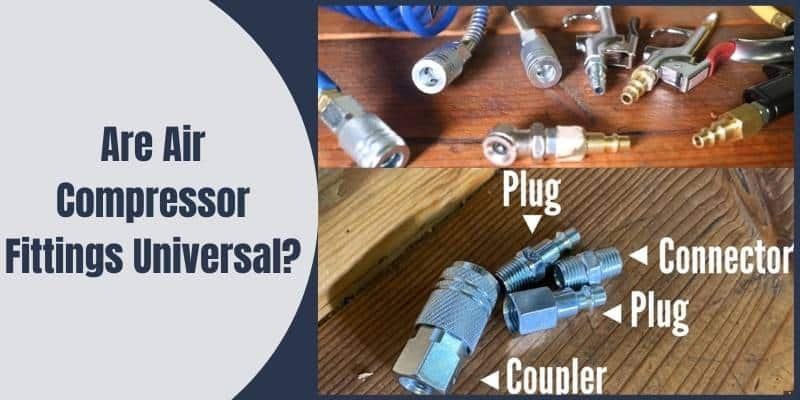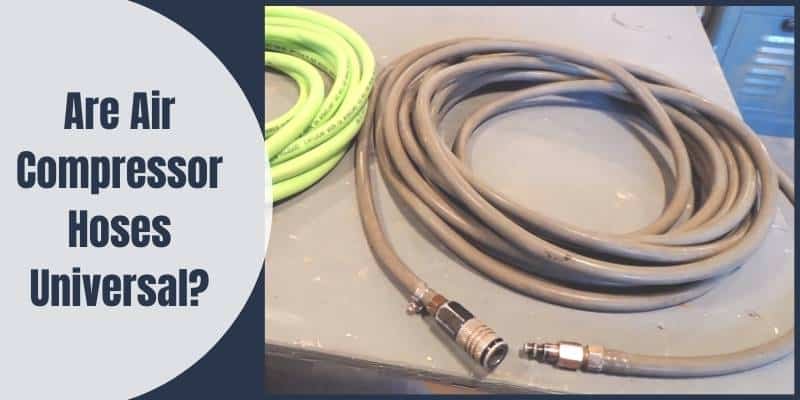Disclosure: This post contains affiliate links and I will be compensated if you make a purchase after clicking through my links. Learn More
Does Tank Size Affect CFM? Ever wondered if the size of your air compressor tank could have a significant impact on its CFM performance? Well, you’re about to find out! In this concise and informative guide, we’ll unravel the mystery behind this crucial relationship, debunk any misconceptions, and provide practical tips to optimize your air compressor setup. So, if you want to supercharge your pneumatic tools and make the most out of your compressor, keep reading!

Does Tank Size Affect CFM?
The tank size of an air compressor indeed affects the CFM (cubic feet per minute) output and performance of the compressor. CFM is a critical metric that indicates the amount of air the compressor can deliver per minute, representing its capacity to power air tools and equipment effectively.
Impact of Tank Size on CFM
- Larger Tank Size: Air compressors with larger tanks typically have a higher CFM output. The larger tank allows for the accumulation of a greater volume of compressed air, enabling the compressor to deliver higher CFM values during short bursts of use.
- Smaller Tank Size: Air compressors with smaller tanks have a limited capacity to store compressed air. As a result, their CFM output may be lower, and they might struggle to sustain continuous high CFM demand.
Use of the Air Compressor
The choice of tank size should align with the intended applications. For tasks that require intermittent bursts of high CFM, a larger tank may be more suitable. For continuous, lower CFM applications, a smaller tank may suffice.
Impact of Tank Size on Air Compressor Performance
The tank size significantly influences the performance of an air compressor. A larger tank can positively impact the compressor’s operation in several ways:
Smoothing Out Air Delivery
A larger tank helps regulate air delivery by reducing pressure fluctuations. It allows the compressor to build up a reserve of compressed air that can be used during peak demand, ensuring a more consistent flow of air to tools and equipment.
Higher CFM Output
With a larger tank, the compressor can deliver higher CFM values during initial bursts of use. This is particularly beneficial when starting air-hungry tools or equipment that require a significant amount of air in a short period.
Reduced Cycle Frequency
Air compressors with larger tanks have longer run times and fewer cycles. This reduces wear and tear on the compressor and can extend its lifespan.
Suitable for High-Demand Applications
In scenarios where air tools or equipment require a continuous high CFM supply, a larger tank can meet these demands more effectively.
While a larger tank has these advantages, it is essential to consider the overall application requirements and balance them with factors such as portability and space constraints.
Advantages of a Larger Tank in Terms of CFM
Using an air compressor with a larger tank offers several advantages related to CFM output and overall performance:
Improved Tool Performance
Air tools with high CFM requirements, such as impact wrenches or sanders, benefit from a larger tank’s ability to supply air consistently without pressure drops.
Enhanced Productivity
With a larger tank, the air compressor can sustain continuous high CFM demands, reducing the need for frequent pauses to refill the tank. This leads to increased productivity, especially in industrial or construction settings.
Minimized Pressure Fluctuations
The larger tank acts as a buffer, reducing pressure fluctuations during air tool operation. This ensures a more stable and reliable air supply to the tools, resulting in smoother operation and better performance.
Suitable for Multiple Users
In situations where multiple users are simultaneously using air tools, a larger tank can meet the collective CFM demands more effectively than a smaller tank.
Versatility
Air compressors with larger tanks can handle a broader range of air tools and equipment, accommodating tools with varying CFM requirements.
Limitations of Using a Larger Tank for CFM
While a larger tank offers advantages in terms of CFM output, there are also some limitations and considerations to keep in mind:
Portability: Air compressors with larger tanks can be heavier and bulkier, which may limit their portability and ease of transportation.
Space Constraints: Larger tanks require more space for storage and operation, making them less suitable for compact or confined workspaces.
Cost: Air compressors with larger tanks tend to be more expensive than those with smaller tanks.
Power Requirements: Compressors with larger tanks may require higher horsepower motors to fill the tank efficiently, resulting in increased power consumption.
Maintenance: Larger tanks may require more maintenance, including regular draining of accumulated condensate to prevent rust and corrosion.
It’s essential to consider these factors and strike a balance between the advantages and limitations when choosing an air compressor based on tank size and CFM requirements.
Can a Smaller Tank Provide Sufficient CFM for Specific Applications?
Yes, a smaller tank can provide sufficient CFM for specific applications, depending on the nature of the tasks and the tools being used. Smaller tanks are often sufficient for applications that require intermittent use of air tools with moderate CFM demands.
For tasks that involve short bursts of air consumption, such as inflating tires or running low-CFM pneumatic tools, a smaller tank can be efficient. Additionally, if the air compressor is used in a space with limited room for storage or if portability is a priority, a smaller tank may be more suitable.
However, for continuous and high-demand applications that require a constant supply of air, such as sandblasting or high-CFM pneumatic tools, a larger tank is more appropriate to ensure a steady and consistent air supply.
Understanding the Relationship Between Tank Size, CFM, and Pressure Requirements
The relationship between tank size, CFM, and pressure requirements is crucial to understanding how an air compressor operates in various scenarios:
CFM and Tank Size
The tank size directly affects the CFM output during air compressor operation. A larger tank can deliver higher CFM values during initial bursts and maintain a more consistent air supply to tools and equipment.
Pressure Requirements
The pressure requirements of air tools and equipment influence the tank size needed. High-pressure tools may require a larger tank to maintain a steady supply of air at the required pressure.
Duty Cycle
The duty cycle, which refers to the compressor’s on/off cycle, is impacted by tank size. A larger tank can reduce the frequency of cycles, allowing the compressor to run for longer periods without overheating.
Tool Compatibility
The choice of tank size should align with the CFM and pressure requirements of the air tools and equipment being used. It’s essential to select an air compressor with a tank size that can accommodate the specific tools in your application.
Choosing the Right Air Compressor Based on CFM and Tank Size
Choosing the right air compressor involves evaluating the CFM and tank size requirements for the intended applications. Here are some steps to help you make an informed decision:
Identify CFM Needs: Determine the maximum CFM requirements of the air tools and equipment you will be using. Consider both continuous and intermittent CFM demands.
Consider Pressure Requirements: Factor in the pressure requirements of your air tools. Some tools may require higher pressure levels, which can influence the choice of tank size.
Assess Tank Size: Evaluate the tank size options available for the air compressors that meet your CFM and pressure requirements. Consider the advantages and limitations of each tank size.
Portability: If portability is essential, prioritize air compressors with smaller tanks, which are typically lighter and easier to transport.
Duty Cycle: If your application demands continuous operation, consider a larger tank that can sustain continuous high CFM demands.
Future Growth: Anticipate future growth or changes in your air tool usage and consider whether a larger tank may be beneficial in the long run.
By carefully considering CFM needs, pressure requirements, and tank size options, you can choose an air compressor that optimally meets the demands of your specific applications.
Factors Affecting CFM Output in Air Compressors
The CFM output of an air compressor can be influenced by several factors:
1. Horsepower (HP): The motor’s horsepower affects the compressor’s ability to produce CFM. Higher horsepower typically results in higher CFM output.
2. Pump Efficiency: The efficiency of the compressor pump plays a crucial role in determining CFM output. A well-designed pump can produce more CFM with less energy consumption.
3. Pressure Rating: CFM output may decrease at higher pressure settings due to increased resistance in the air compressor system.
4. Air Leakage: Air leaks in the compressor system can result in decreased CFM output, as not all compressed air reaches the intended application.
5. Ambient Temperature: Higher ambient temperatures can affect the compressor’s performance and CFM output.
6. Piping and Hose Size: Properly sized piping and hoses can optimize CFM delivery to tools and equipment.
Understanding these factors can help users optimize their air compressor’s CFM output and ensure it aligns with the requirements of their applications.
Common Misconceptions About Tank Size and CFM
There are some misconceptions surrounding tank size and CFM in air compressors:
Larger Tank = Higher CFM
While a larger tank can provide higher CFM output during short bursts, it does not necessarily increase the compressor’s CFM production rate.
Small Tanks Are Ineffective
Smaller tanks are suitable for certain applications that do not demand continuous high CFM. They can be efficient for tasks with intermittent air usage.
Tank Size Alone Determines Performance
Tank size is just one factor that affects the overall performance of an air compressor. Consider other factors like pump efficiency, horsepower, and duty cycle for a comprehensive evaluation.
CFM is the Only Important Metric
While CFM is vital for air tools and equipment, other factors, such as pressure requirements, tank size, and duty cycle, should be considered when choosing an air compressor.
Larger Tanks Always Require More Power
While larger tanks may require more power to fill, the compressor’s horsepower and efficiency also play significant roles in power consumption.
Addressing these misconceptions can help users make well-informed decisions when selecting air compressors based on tank size and CFM requirements.
Conclusion
The tank size of an air compressor indeed affects CFM output and performance. Larger tanks can deliver higher CFM during short bursts and provide a consistent air supply to air tools and equipment. However, tank size is not the sole determinant of an air compressor’s performance. Factors like pump efficiency, horsepower, pressure requirements, and duty cycle also play crucial roles in optimizing CFM delivery.
Choosing the right air compressor based on CFM and tank size requires a careful evaluation of specific application needs, considering factors like tool requirements, portability, and future growth.
By understanding the relationship between tank size and CFM and addressing common misconceptions, users can make informed decisions and select air compressors that best suit their requirements. Properly matched air compressors can lead to improved productivity, enhanced tool performance, and overall operational efficiency.


